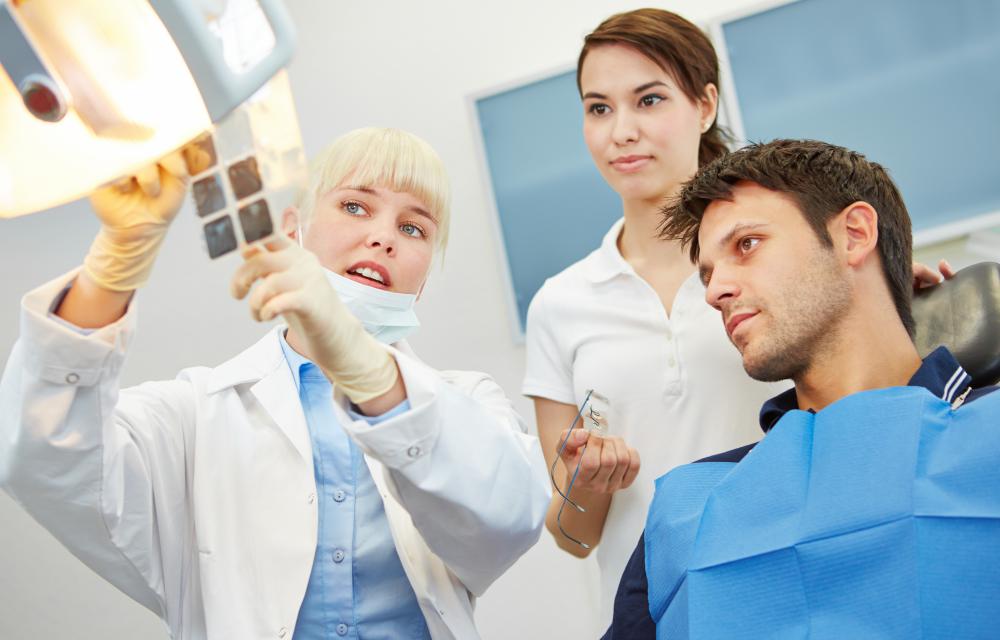At WiseGEEK, we're committed to delivering accurate, trustworthy information. Our expert-authored content is rigorously fact-checked and sourced from credible authorities. Discover how we uphold the highest standards in providing you with reliable knowledge.
What is Glossodynia?
Glossodynia, also known as burning mouth syndrome (BMS), is a medical condition characterized by a sensation of burning pain that affects the inside of the mouth. BMS may cause tongue pain or discomfort and irritation that affects the gums, roof of the mouth, cheeks, or lips. Glossodynia may be triggered by a variety of factors and classified as either a primary or secondary condition, depending on its cause. Treatment is dependent on the presentation of the condition and the overall health of the individual.
There are two classifications utilized to determine the cause for the development of glossodynia. If the origin of the syndrome is unknown, the condition is referred to as idiopathic or primary BMS. When the disorder is caused by an underlying condition, it is known as secondary burning mouth syndrome.

Individuals who experience persistent dry mouth due to the use of certain prescription medications may develop signs of glossodynia. Those with nutritional deficiencies, anxiety, or dentures may be at an increased risk for developing symptoms associated with burning mouth syndrome. Certain medical conditions, including hormonal imbalances, acid reflux disease, and endocrine disorders such as diabetes, may also lead to the development of glossodynia.

Those who develop this rare condition may experience a variety of symptoms that affect areas within the mouth, including the tongue, gums, and cheeks. Symptoms that manifest may include numbness or tingling of the tongue, persistent dry mouth, and excessive thirst. The most common symptom is a sensation of burning that may affect certain areas within the mouth or the whole mouth. Additional signs of glossodynia may include impaired taste and a complete inability to taste.

Symptoms associated with this condition may manifest periodically and affect different areas within the mouth each time. Some people experience pronounced pain that may last for several days or weeks at a time. Others may experience periodic episodes of mild discomfort or irritation that only last a few days accompanied by an absence of symptoms for several days between episodes. Individuals may experience periodic symptoms for years before a diagnosis of BMS is confirmed.
There is no single diagnostic test that may be performed to confirm that an individual has BMS. A diagnosis is generally made once the possibility of other conditions has been ruled out. Initially, a review of the individual’s medial history may be conducted followed by an examination of his or her mouth. Following a preliminary examination, additional tests may be performed to assess the person's overall health and to check for any underlying conditions. Use of certain prescription medications may be discontinued to evaluate whether their use is contributing to the symptoms.
Blood tests may be administered to assess the individual’s glucose levels and immune and thyroid function. In some cases, imaging testing that includes the employment of magnetic resonance imaging (MRI) and a computerized tomography (CT) scan may be performed to evaluate whether an underlying condition may be present. Oral cultures may be taken to rule out the presence of any viral, fungal, or bacterial infection.
Since there is no single approach for treating this condition, treatment for BMS is dependent on symptom manifestation. Individuals with secondary BMS often find their symptoms decrease or subside once the underlying condition is treated successfully. Cases of idiopathic glossodynia may be more difficult to treat, since there is no discernible cause and no cure for the condition. Finding a therapy regimen that aids with reducing or alleviating symptoms may take time.
Most often, individuals with primary BMS employ a variety of combinations of therapy before finding one that works. Approaches that involve the use of oral medications, supplements, and mouth rinses or washes may be utilized. Individuals whose symptoms are related to psychological factors, such as anxiety or depression, may find relief with the administration of antidepressant medication. Nutritional deficiency-induced BMS may be alleviated with the use of supplements, such as B vitamins or folic acid. Additional treatment options may involve the use of anticonvulsant medications administered in the form of throat lozenges, dietary changes to increase the presence of antioxidants in the body, and use of products to increase salivary production.
Complications associated with this condition may include mood changes, insomnia, or loss of appetite. Those who have a known food allergy, are diagnosed with an upper respiratory tract infection, or are taking certain prescription medications may be at an increased risk for developing glossodynia. Recent dental procedures and unusually high amounts of stress, such as experiencing a traumatic event, also increase an individual’s susceptibility to this condition.
AS FEATURED ON:
AS FEATURED ON:













Discuss this Article
Post your comments